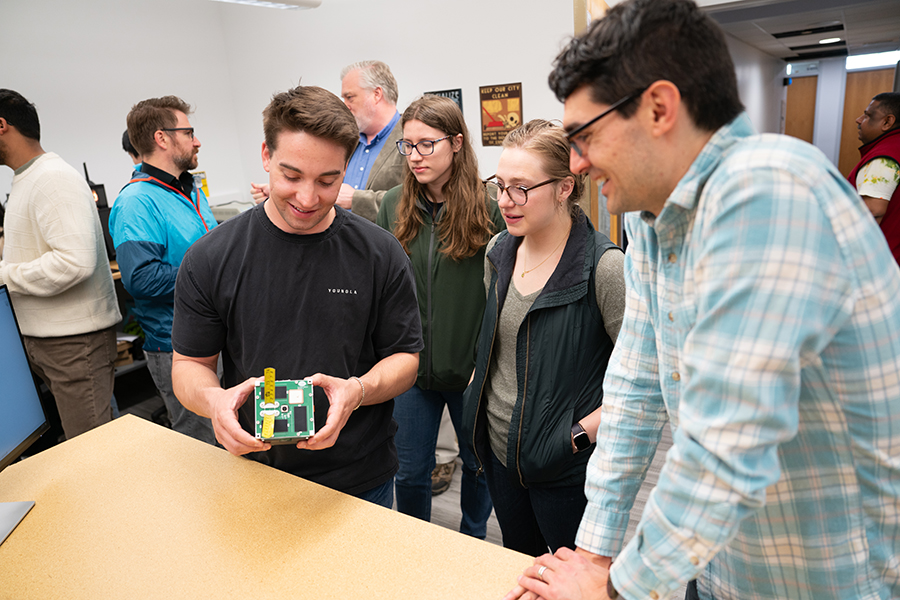CMU Class Builds Satellite Bound for Earth's Orbit
Tuesday, June 18, 2024


It's spring on the Carnegie Mellon University campus, and students divided into teams focused on communications, guidance navigation and control (GNC), and vision have their heads together trying to simulate how a satellite collects and transmits usable images. Across the room, their peers on the avionics team have laid out rows of circuit boards and are explaining how they can push updates to the satellite when it's in space. The room is buzzing, but it stops for the mechanical team, which has reached a critical juncture. They need pieces of fishing line to break.
Ashley Kline, a master's student in mechanical engineering, throws her arms up in celebration when the translucent strings snap and solar panels unfold from the sides of the cube satellite. It needs power when it's in space to accomplish its mission: keeping track of itself in orbit.
All this excitement erupted during demonstration day for CMU's Spacecraft Design-Build-Fly Lab course, which brings together students from the College of Engineering, Mellon College of Science and the School of Computer Science for two semesters to design and build a small satellite that will launch into space next year. Zac Manchester, an assistant professor in the Robotics Institute (RI), and Brandon Lucia, a professor in the Electrical and Computer Engineering Department (ECE), led the class.
"I would have loved to have this class as a student," Manchester said.
Small satellites, known as nanosatellites, can be useful for agriculture, disaster response or scientific research. But to use these devices, researchers need to know where they are in orbit, which can be an expensive and imprecise undertaking. Kyle McCleary, an ECE Ph.D. student and teaching assistant for this class, has been researching the use of visual sensing and machine learning algorithms to improve orbit determination on these small satellites. In the course, McCleary and about 30 students put this research into practice.
Students were divided into five teams: communications, avionics, mechanical, GNC and vision. This structure reflects the subsystem teams one would see at NASA or other space exploration companies.
The communications team was responsible for radio commands sent to and from the satellite while in space. The satellite's antenna, made from a bright yellow measuring tape, delivers images and measurements to the teams to help them determine where the satellite is located. The team also built a ground station that's been receiving information from the cube satellites Manchester launched in early March.
Rohan Raavi, a senior in ECE, was on the avionics team. He joked that he tried not to think too much about this satellite going to space because of the pressure. But he said he loved the class.
"It shows you how much more there is to learn and how much room there is for advancement in this area of science and engineering," Raavi said. "The space industry has been focusing a lot on reliability because they don't want to risk failure, meaning there's a lot of room for progress and improvement, like what we are doing in this course."
The avionics team designed the satellite's circuit boards and the software needed to execute commands. Their work needed to get to space, which is where the mechanical team came in. They ensured everything was built correctly to fit into the rocket and that the satellite switched on and deployed its solar panels when the device got to space.
When Manchester came to CMU, he and Lucia teamed up to launch this course. He said telling the students this satellite was going to space gave the students a sense of seriousness, knowing this project would end up in Earth's orbit contributing to new research.
The students in this class started from a mission concept, Lucia explained.
"These students are so impressive. These are mission requirements that professional engineers fail to accomplish, but they've created something that's ready to fly," he said.
The GNC and vision teams collaborated closely on the mission's main objective — determining where the satellite is in orbit. Six cameras mounted to the satellite capture images of Earth and identify landmarks. The GNC team ensures that the vision team can make accurate measurements by slowing and controlling the satellite's rotation. Electricity flows through coiled wires in the satellite, turning it into a magnet that interacts with Earth's magnetic field. Using clever algorithms, GNC can adjust the amount of current in these coils to control the satellite's rotation.
Once the satellite is correctly oriented to take images, the vision team uses cameras and machine learning to handle the final step: determining the satellite's location. Images of Earth pass through a region of interest (ROI) classifier, which identifies predefined locations of interest in these images — something easily identifiable like an inland lake. The team then uses this data to determine the satellite's position and velocity.
Haochen Zhang, a master's student in RI, was on the vision team. She explained this was the first course she's taken where the whole class worked on one project from beginning to end.
"I got to work on something that I'm interested in, vision, and I got to experience and learn about other people's specialties while watching this mission come together," Zhang said.
When the demo day ended, everyone gathered for a team photo, filling in around a table that held their satellite. Lucia and Manchester said they intend to keep this class going. The mission concept for the next offering will use processors developed by CMU spin-out, Efficient Computer, a company Lucia co-founded to develop chips that will provide the satellites with the capability to do on-board computing on sensor data with unprecedented efficiency.
For More Information
Aaron Aupperlee | 412-268-9068 | aaupperlee@cmu.edu